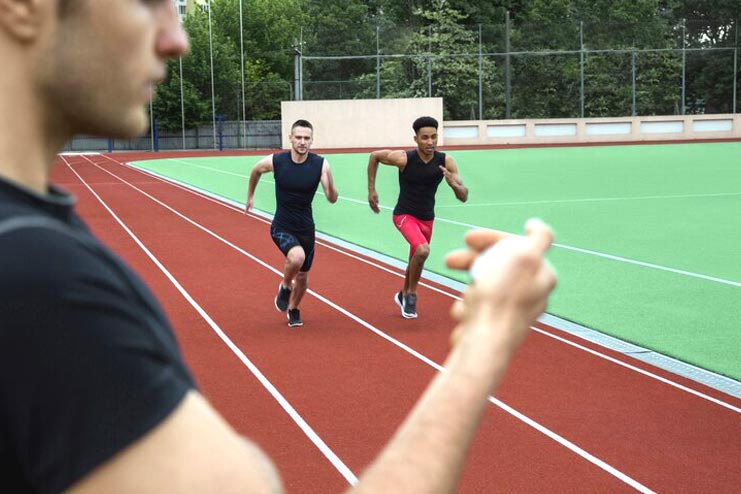Affiliate Disclaimer
Some links in this article are affiliate links. We may earn a small commission if you make a purchase through these links, at no extra cost to you. We only recommend products we find useful to our readersStarting as a beginner runner has two benefits: Running improves physical health and gives you a sense of success. Increasing your running endurance is essential for beginners since it sets the stage for a more robust, healthier lifestyle. It is a significant undertaking that touches on mental health, general vigor, and cardiovascular fitness. People who add running challenges to their habits regularly and steadily might reap numerous rewards far beyond crossing the finish line.
The secret to long-term success in running challenges is to tackle them gradually and consistently. This method helps new runners gradually increase their endurance while reducing the chance of injury and helping them adjust to the physical demands of running. It becomes more than just a race against time; it becomes a customized journey toward increased fitness.
Why Running Challenges Matter

For novices, structured running challenges are essential since they provide a path to overall health and well-being. These challenges offer a structure that helps those new to running become physically fit and develop resilience and discipline. Taking part in running challenges provides an organized method essential for novices. The thoughtfully designed programs accommodate a range of fitness levels by progressively ramping up the intensity to enable participants to adjust and advance at a speed that best fits their unique talents. This methodical technique guarantees a sustainable and pleasurable running experience while reducing the chance of injury.
Maintaining a regular running schedule is essential for improving endurance and cardiovascular health. By participating in running challenges regularly, novice runners activate their cardiovascular system, which promotes enhanced oxygen transport and blood circulation. It eventually leads to a more robust heart, expanded lung capacity, and improved general endurance. Because these challenges are incremental, individuals are encouraged to gradually push their limitations, promoting adaptation and reducing the risk of burnout or overexertion.

Running difficulties have significant psychological and physical benefits. Establishing and meeting small exercise objectives improves self-esteem and gives a sense of achievement. Conforming to obstacles cultivates a persistent mindset that benefits other aspects of life. Endorphins are released when certain milestones are reached, which lowers stress and improves mental clarity. The psychological advantages of running challenges become a strong motivation for novices as they see their development gradually take shape. It reinforces the significance of running challenges as a comprehensive approach to well-rounded health and fitness.
Related Article: Sweat it Out: 12 Compelling Reasons Why Physical Activity is Your Best Medicine
Week 1 Challenge: Establishing the Routine

Starting a running journey can be thrilling and challenging for inexperienced runners. Establishing a consistent daily running schedule that serves as the cornerstone for future development is the primary goal of Week 1. A modest introduction is essential for beginners, and a daily commitment of 15 to 20 minutes offers an affordable yet effective place to start.
Daily Running Schedule: Whether in the morning, around lunch, or in the evening, beginners are advised to set up a specified time each day for their run. A daily routine’s constancy helps people build habits. A recommended starting time of 15 to 20 minutes finds a balance between increasing stamina and avoiding exhaustion.
Combination of Fast Walking and Jogging Intervals: Novices should begin with a combination of fast walking and jogging intervals to ease themselves into the regimen. This method reduces the chance of injury while enabling the body to progressively adjust to the physical demands of running. For instance, alternate between jogging for one minute and vigorous walking for two minutes. The amount of time spent jogging can be increased as fitness levels rise.
The significance of warm-ups and cool-downs: A suitable warm-up is essential before each session to prime the body for the forthcoming physical activity. Dynamic stretches, leg swings, and mild aerobic activities improve flexibility and blood flow. Likewise, a cool-down is necessary after a run to prevent muscle stiffness and progressively drop heart rate. Static stretches that focus on large muscle groups help to guarantee a well-rounded and injury-free running experience.
A successful and joyful running journey can be set for beginners by gradually emphasizing a disciplined routine and introducing running intervals.
Week 2 Challenge: Increasing Duration and Distance

When novice runners advance past the first few miles of their running trip, the emphasis switches to progressively lengthening and expanding their everyday runs. Building on the groundwork laid in Week 2, this challenge encourages a progressive methodology corresponding to each person’s changing fitness level.
Increase Daily Running Time Gradually: During this stage, participants are urged to increase the length of their runs by five to ten minutes each day. The body can adjust to the increasing demands of running thanks to this gradual increase without becoming overtaxed. For instance, if running for 15-20 minutes a day was the goal in Week 1, Week 2 may aim for 20–30 minutes.
Add Brief Intervals of Continuous Jogging or Moderate Running: During the longer workouts, add brief intervals of continuous jogging or moderate running to improve cardiovascular endurance. As your fitness level rises, progressively extend the length of your jogging intervals from one to two minutes. This evolution prepares the cardiovascular system and muscles for longer, sustained exertion.
Please keep a steady pace and pay attention to your body’s cues. In this phase, consistency is vital, so newbies should find a comfortable pace that will allow them to cover more ground without compromising form. It becomes essential to pay attention to your body’s signals. If you feel tired or uncomfortable, you can quickly slow down or add short walking intervals to your workout.
Beginners can enhance their physical endurance and better understand their body’s potential by gradually increasing their running distance and duration. This consistent progress sets the foundation for more ambitious future running goals.
Week 3 Challenge: Improving Pace and Form

As runners progress through their journey, the emphasis changes from longer duration to improving speed and form. This challenge aims to enhance the running experience by refining techniques, optimizing efficiency, and including structured intervals.
Increase Your Running Pace by Introducing Structured Intervals: Include planned intervals in the workout to increase your running pace. Start with brief accelerations and alternate between moderate walking or jogging intervals. For example, switch off between one minute of running and two minutes of walking. This method improves overall pace by strengthening cardiovascular fitness and teaching the body to tolerate different speeds.
Focus on Appropriate Form and Technique for Running: Maintaining good running form is crucial to avoiding injuries and increasing productivity. For beginners, maintaining an erect stance, a loose yet focused gait, and a mid-foot landing should be their key priorities. Breathing should be regular, and arms should swing freely. Maintain appropriate form throughout runs by evaluating it frequently and making any adjustments. It will help you perform at your best and lower your chance of strain.
Include Strength Training in Your Running Routines: Strength training will help improve your running technique and pace. Focus on essential muscle groups, such as the legs, glutes, and core, with bodyweight exercises, resistance training, or cross-training activities. Increasing the strength in these areas improves overall running mechanics, decreases fatigue, and increases stability.
Running athletes who take on the challenge of increasing their pace and form improve their performance and lower their chance of injury from bad form. This stage lays the groundwork for future development and success by representing a significant step toward becoming a more capable and efficient runner.
Conclusion

The art of slow improvement is the thread that weaves success in the goal of endurance building. We have discussed the importance of gradual progress, understanding that long-term results come from steady work over time. As newbies, you’ve set the foundation for a stronger and more resilient way of living by realizing that endurance is a sign of your dedication and willpower rather than merely a physical quality.
Start your running adventure with a fresh dedication to steady improvement. Keep a careful eye on your development, and remember to celebrate the little accomplishments along the road.
Every stride forward is a victory, paving the way for long-term perseverance. You could step up the difficulty by learning more complex running tactics or establishing challenging objectives. If you want customized advice, please do not hesitate to contact experts who can offer insightful advice. The endurance journey is a never-ending experience that changes not only your physical but also your mental state.
Recommended Articles:
- 18 Resistance Band Exercises For A Healthier Physique
- 8 Bodyweight Exercises for Strength – Do They Make You Stronger?
- 5 Effective Knee Strengthening Exercises
Reference
https://www.runnersworld.com/uk/training/beginners/a772727/how-to-start-running-today/
https://optimizeottawa.com/the-skill-of-running/#:~:text=Running%20takes%20skill%20and%20practice,practice%20and%20repetition%20to%20master.
https://www.everydayhealth.com/fitness/how-to-start-running-an-absolute-beginners-guide/
https://www.runnersworld.com/beginner/a31707889/best-beginner-running-plan/
https://www.runnersworld.com/training/a20845020/how-to-get-started-as-a-runner/
https://zenhabits.net/beginners-guide-to-running/
https://www.verywellfit.com/how-to-do-the-runwalk-method-2911203
https://www.verywellfit.com/how-to-run-faster-and-improve-race-times-2911291
https://www.endurancenation.us/run/running-form-before-run-speed-or-volume/
In this Article




















